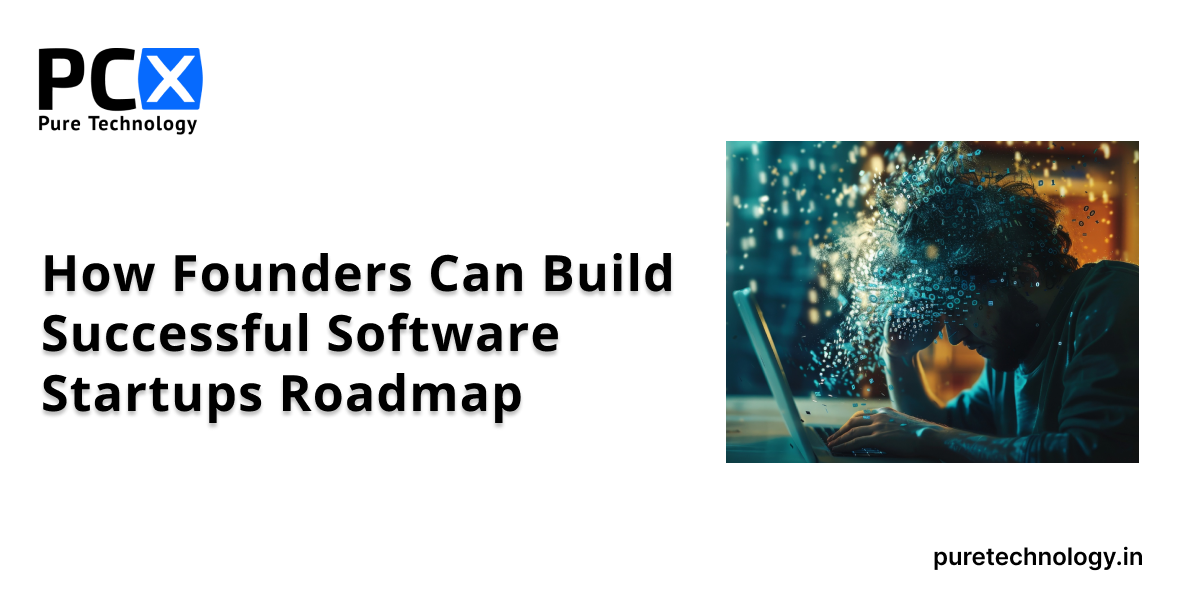How Founders Can Build Successful Software Startups – Step-by-Step Roadmap
In today’s digital-first world, having a brilliant idea is not enough—execution with the right technology is what sets startups apart. Studies show that nearly 90% of startups fail, often because they lack the right tech strategy or scalable software solutions.
For modern founders, building a web or mobile application isn’t just an option—it’s the engine that powers growth. But where do you begin? How do you ensure your idea transforms into a product that investors, users, and the market love?
At Pure Technology, we’ve helped countless founders transform raw ideas into future-ready digital products. This roadmap is designed to guide startup founders through every stage of software development—from MVPs to full-scale platforms.
What is Startup Software Development?
Startup software development goes beyond writing code—it’s about aligning your vision, speed, and scalability with the right digital solutions. Unlike enterprise development, which focuses on long-term, heavy structures, startup software development is lean, agile, and built for rapid growth.
- 🚀 Rapid Prototyping & MVPs to test and pivot quickly.
- ⚡ Scalable Architecture that evolves with your business.
- 💡 User-Centered Design to win adoption fast.
- 📈 Agile Methodology to move at startup speed.
In the startup ecosystem, the formula is simple:
Speed + Strategy = Survival.
What is an MVP and Why Does It Matter?
An MVP (Minimum Viable Product) is the simplest, functional version of your product—built with only the essential features. Its purpose? To validate your idea with real users before investing heavily.
Why MVPs Are Critical for Startups
- Validate your business idea in the real market.
- Attract early adopters and investors.
- Gather feedback for rapid improvements.
- Avoid wasting time and money on untested features.
Real-World MVP Success Stories
- Amazon – Began as a simple online bookstore before becoming the world’s largest marketplace.
- Dropbox – Tested the concept with a short demo video before writing full code.
- Spotify – Started with a desktop-only MVP focused on one feature: music streaming.
Lesson: The fastest way to grow is to launch smart, not big.
How Much Does Startup Software Development Cost?
Costs vary based on complexity, features, and location. A basic MVP can range from $15,000 – $50,000, while a fully scalable product may exceed $200,000+.
Cost Breakdown by Stages
- Requirement Analysis – $1,000 – $5,000
- UI/UX Design – $2,000 – $10,000
- Planning & Architecture – $1,000 – $2,000
- Development & Coding – $10,000 – $200,000+
- QA & Testing – 15–25% of total development cost
- Project Management – 10–20% of total development cost
- Maintenance & Updates – 15–20% annually
👉 Pro Tip: Start lean with an MVP, test, then scale.
Average Developer Hourly Rates by Region
Choosing the right development team is crucial for budget and quality. Rates vary by region:
- USA/Canada – $100 – $200/hr
- Western Europe – $50 – $120/hr
- Eastern Europe – $30 – $60/hr
- India & Southeast Asia – $25 – $50/hr
- Latin America – $30 – $50/hr
For early-stage founders, outsourcing is often the smartest choice—it reduces costs while giving you access to global talent.
Outsourcing Startup Software Development: Smart or Risky?
Outsourcing is a cost-effective and faster way for startups to build software. Benefits include:
- 🌍 Access to skilled global developers
- ⏱ Faster time-to-market
- 💸 Lower operational costs
- 🔄 Flexibility to scale your team as needed
The key is choosing the right development partner—one who understands startup challenges.
Where to Find Reliable Developers
Top platforms to hire startup developers:
- Upwork – Flexible hiring for freelancers.
- Toptal – Pre-vetted top 3% of global talent.
- Clutch & GoodFirms – Agency-focused with reviews.
- GitHub Jobs – Great for finding passionate coders.
Top Interview Questions for Startup Developers
When hiring for a startup, you need problem-solvers, not just coders. Ask questions like:
- Tell me about a project you built from scratch.
- How do you handle last-minute pivots?
- What happens if a feature fails before launch?
- Have you worked on an MVP before?
- Do you prioritize speed or perfection?
Look for developers who embrace agility, adaptability, and startup grit.
Choosing the Right Tech Stack for Startups
The best tech stack depends on your goals, timeline, and budget.
For Web Apps (MVPs)
- MERN (MongoDB, Express.js, React, Node.js)
- MEAN (MongoDB, Express.js, Angular, Node.js)
✔ Scalable & fast
✔ Strong community support
✔ Reusable components
For Mobile Apps
- React Native
- Flutter
✔ Cross-platform (iOS + Android)
✔ Faster development cycles
For AI/Data-Driven Apps
- Python + Django/FastAPI + TensorFlow
✔ Best for machine learning & automation
✔ Handles large-scale data efficiently
Why Choose Pure Technology as Your Startup Partner?
At Pure Technology, we don’t just write code—we co-build startups. Whether you’re validating an idea with an MVP or scaling to enterprise-level, our team specializes in startup-focused software development.
What we bring to founders:
- Agile, lean development processes
- Startup-friendly tech stacks
- Rapid prototyping & MVP delivery
- Scalable architecture for growth
- End-to-end support from ideation to launch
We help founders move faster, scale smarter, and win bigger.
Conclusion
Startup success depends on speed, strategy, and execution. With the right tech stack, a lean MVP, and a trusted development partner, you can transform your vision into a market-ready product—and scale towards becoming the next unicorn.
If you’re a founder ready to take the leap, Pure Technology is here to be your tech backbone. Let’s turn your idea into a scalable product that thrives in today’s competitive market.
Call us for a professional consultation












Leave a Reply